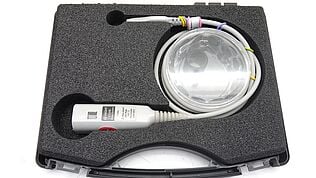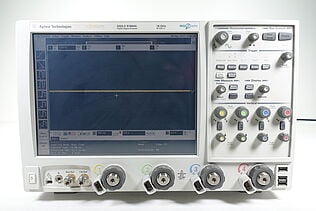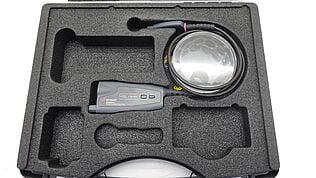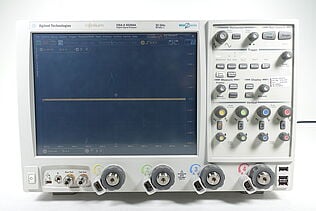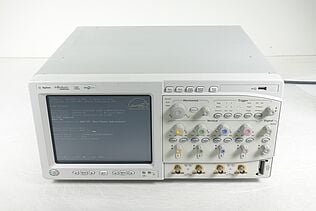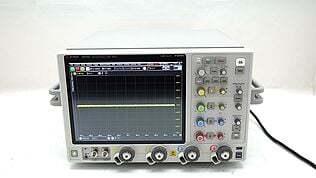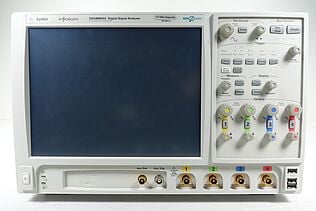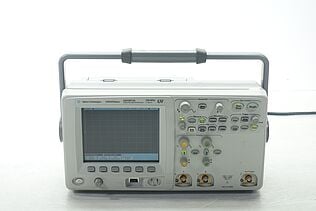- Introduction
- What is Peak Detection?
- How Does it Work?
- Why is Peak Detection Important?
- For Transient Events
- For High-frequency Signals
- Peak Detection vs. Normal Sampling
- Types of Peak Detection: Hardware vs. Software
- Hardware-based Peak Detection
- Software-based Peak Detection
- How to Enable Peak Detection: A Step-by-Step Guide
- Practical Applications of Peak Detection
- Signal Integrity Testing
- Glitch Detection
- Digital Circuit Debugging
- High-frequency Analysis
- Conclusion
- Whenever You’re Ready, Here Are 5 Ways We Can Help You
Imagine designing a cutting-edge, high-frequency system, only to find that your oscilloscope misses capturing the very transient events that could cause your circuit to fail. Sounds like an engineer's nightmare, doesn't it?
Peak detection in oscilloscopes comes to the rescue, allowing for the capture and analysis of rapid events that a typical sampling technique would likely overlook.
For electrical engineers dealing with increasingly complex and high-speed systems, understanding peak detection is more than just a feature on an oscilloscope—it's an essential tool for effective signal analysis.
What is Peak Detection?
Peak detection identifies the highest and lowest amplitude levels within a particular sampling interval. This feature allows oscilloscopes to record transient events that may otherwise go unnoticed.
How Does it Work?
- Sample the signal: The oscilloscope samples the incoming signal.
- Store the values: It keeps track of the highest and lowest points during each sampling interval.
- Display the peaks: Finally, the oscilloscope displays these peak values on the screen.
| Key Takeaway |
|---|
| Peak detection is a vital tool for capturing transient and high-frequency events, providing crucial insights that enable accurate signal analysis and system debugging. By leveraging its capabilities, engineers can significantly enhance the reliability and performance of a wide range of electronic systems. |
Discover the Exceptional Value: Refurbished Oscilloscopes from Keysight
Why is Peak Detection Important?
When assessing electrical signals, it's all about the details. In a world driven by high-frequency systems and transient events, missing a glitch or fast transition isn't just a minor oversight—it could lead to system failures or flawed designs. That's where the importance of peak detection comes into play.
Let's delve into why peak detection holds critical value, especially in the realm of transient events and high-frequency signals.
For Transient Events
- Capture elusive details: With traditional sampling methods, rapid voltage changes might go undetected, especially if they occur between two sampling points.
Peak detection eliminates this blind spot. By continuously monitoring the highest and lowest values within a sampling interval, it ensures that even the briefest events get recorded.
This is particularly important in applications like fault detection, where missing a short-lived transient can have serious implications. - Data integrity: In electronics, aliasing isn't just a graphical term; it's a signal integrity issue.
When the oscilloscope samples at a rate that is too slow to capture the signal changes adequately, aliasing occurs. This leads to a distorted representation of the original signal, which can be misleading and result in incorrect analyses.
Peak detection maintains the integrity of your signal by providing a more accurate representation, minimizing the chances of aliasing. - Analysis: In-depth signal analysis often requires a closer look at transient events, whether you're troubleshooting a circuit or validating a new design. Peak detection provides the granular detail necessary for such advanced diagnostics.
By capturing and storing the high and low points of rapid changes, it allows you to scrutinize your signals at a microscopic level, aiding in effective troubleshooting and optimization.
For High-frequency Signals
- High-speed analysis: As systems continue to evolve, operating at ever-higher frequencies, the need for faster and more accurate measurement tools becomes paramount.
Peak detection offers an effective way to analyze high-frequency or high-speed signals where traditional sampling methods fall short.
This is crucial for applications like RF circuit design, high-speed data transmission, and microwave systems. - Detailed observations: When dealing with high-frequency signals, missing out on fast transitions, glitches, or other quick events is not an option.
Traditional sampling methods might fail to capture these critical components of your signal, leading to incomplete or flawed analyses. Peak detection fills in these gaps.
It continuously tracks the highest and lowest points of the signal within each sample interval, ensuring that you capture all relevant data for comprehensive observations and analyses.
By offering the capability to capture fast, transient events and provide detailed observations of high-frequency signals, peak detection serves as an indispensable tool in the modern electrical engineer's toolkit.
Peak Detection vs. Normal Sampling
| Feature | Peak Detection | Normal Sampling |
|---|---|---|
| Sampling rate | Higher | Lower |
| Data integrity | Maintains | May compromise |
| Capture speed | Fast | Moderate to slow |
| Processing power | High | Moderate |
Types of Peak Detection: Hardware vs. Software
Navigating the complexities of signal analysis often boils down to choosing the right tools, and peak detection is no exception.
Engineers generally have two options for peak detection: hardware-based and software-based methods.
Each offers distinct advantages and limitations, and knowing when to employ which can be the difference between accurate diagnostics and misleading results.
Hardware-based Peak Detection
- Immediate results: Hardware-based systems deliver real-time peak detection, making them ideal for applications requiring instantaneous decision-making like automated testing or real-time monitoring.
- Exceptional speed: One significant advantage of hardware-based peak detection is its high-speed sampling capability. Specialized circuits can sample signals at a rate much faster than most oscilloscopes in standard modes. This becomes crucial for handling very high-frequency applications like radar systems or high-speed data communications.
Real-time Peak Detection
Real-time peak detection uses specialized hardware circuits to identify and record the maximum and minimum levels of an incoming signal within a predefined time interval, providing immediate insights.
High-speed Sampling
Hardware-based systems often excel in high-speed sampling, thanks to dedicated integrated circuits. These circuits allow for sampling rates that surpass those achievable through standard sampling methods, making them the preferred option for high-frequency applications.
Software-based Peak Detection
- In-depth analysis: Software-based systems allow for intricate post-capture analysis, making them well-suited for research and development projects where flexibility is essential.
- Customizability: One of the strengths of software-based peak detection is the ability to customize algorithms and re-analyze data under different parameters, offering engineers a more tailored approach to signal analysis.
Post-capture Analysis
After capturing the signal data, software-based peak detection comes into play. Specialized software identifies the peak values within the captured data, allowing for a more flexible and in-depth analysis, ideal for research and development contexts.
Flexible but Slower
The flexibility of software-based systems is unparalleled, allowing engineers to tweak algorithms, adjust parameters, and even integrate peak detection into broader data analysis workflows. However, this flexibility often comes at the expense of processing speed, especially when dealing with large data sets or complex analysis algorithms.
By understanding the strengths and limitations of hardware-based and software-based peak detection, engineers can choose the most effective approach for their specific needs, ensuring accurate and efficient signal analysis.
How to Enable Peak Detection: A Step-by-Step Guide
Activating peak detection is generally a straightforward process, but the specifics can vary depending on the make and model of your oscilloscope. However, the fundamental steps remain relatively consistent across different platforms.
Here is a detailed guide on how to enable peak detection:
- Turn on and connect: Power up your oscilloscope and connect it to the device or signal source you wish to analyze.
- Locate sampling menu: Navigate to the oscilloscope's menu and find the section related to sampling options, often labeled as "Acquire," "Sampling," or a similar term.
- Open sampling menu: Access this sampling options menu to view various sampling modes and settings.
- Find 'peak detect' mode: Scroll through the list of available sampling modes to locate the 'peak detect' option or its equivalent.
- Select 'peak detect': Choose the 'peak detect' mode to activate it for your signal analysis.
- Configure time window: Look for an option to set the time interval or window for peak detection within the 'peak detect' settings.
- Set desired interval: Adjust the time interval to the desired value, which could be in microseconds, milliseconds, or other time units based on your specific needs.
- Confirm settings: Press the "Apply," "OK," or "Confirm" button to save your newly configured peak detection settings.
- Exit menu: Close the settings menu and return to the main screen of your oscilloscope.
- Initiate analysis: Press the "Start" or "Run" button on your oscilloscope to begin capturing and analyzing signals with the enabled peak detection mode.
Practical Applications of Peak Detection
Peak detection serves as a crucial tool across multiple facets of electrical engineering and related disciplines.
Its key strength lies in capturing transient and high-frequency events with remarkable accuracy, making it a go-to choice for several practical applications.
Signal Integrity Testing
- Shape preservation: Ensures that high-speed signals maintain their original shape.
- Amplitude checks: Helps in verifying that the signal amplitude remains consistent across its path.
Signal integrity is critical in systems where high-speed data transmission is crucial. Peak detection plays an essential role in ensuring that both the shape and amplitude of the signal are maintained.
Glitch Detection
- Real-time monitoring: Identifies glitches or spikes as they occur.
- Diagnosis: Enables detailed study of the glitch to pinpoint the root cause.
Glitches in a signal often indicate underlying issues. Peak detection allows for immediate identification and thorough diagnosis of these irregularities.
Digital Circuit Debugging
- Signal inspection: Assists in scrutinizing digital signals for errors or irregularities.
- Timing analysis: Helps in ensuring that digital signals meet timing requirements.
Debugging digital circuits often involves a close inspection of signal integrity and timing. Peak detection aids in both, thereby ensuring error-free operation.
High-frequency Analysis
- Frequency domain: Useful for analyzing the frequency components in high-frequency applications like RF circuits.
- Transient response: Captures quick changes in high-frequency circuits to assess their performance.
In high-frequency applications, peak detection offers invaluable insights, whether you're examining the spectral components or transient responses.
By employing peak detection, engineers can achieve higher reliability and performance across various electronic systems.
Discover Keysight's Range of Certified Refurbished Oscilloscopes
Select up to 3 instruments to compare
Enable Notifications
In order to use this feature, you need to enable notifications.
Manage notification preferences
Conclusion
Peak detection serves as an indispensable tool in the arsenal of electrical engineers and professionals in related fields.
From ensuring signal integrity in high-speed systems to debugging digital circuits and analyzing high-frequency signals, its applications are as diverse as they are critical.
With the right kind of peak detection capabilities, you're not just measuring signals; you're ensuring the reliability, efficiency, and success of your projects.
If you're in the market for high-quality measurement equipment that includes advanced peak detection features, look no further than Keysight Used Equipment Store.
Keysight offers a range of premium used oscilloscopes, spectrum analyzers, waveform generators, and multimeters.
Elevate your signal analysis capabilities today by investing in equipment you can trust.

Whenever You’re Ready, Here Are 5 Ways We Can Help You
- Browse our Premium Used Oscilloscopes.
- Call tech support US: +1 800 829-4444
Press #, then 2. Hours: 7 am – 5 pm MT, Mon– Fri - Talk to our sales support team by clicking the icon (bottom right corner) on every offer page
- Create an account to get price alerts and access to exclusive waitlists.
- Talk to your account manager about your specific needs.

